|
|
 |
Canadian Historic Sites: Occasional Papers in Archaeology and History No. 19
Yukon Transportation: A History
by Gordon Bennett
The Pattern Emerges
I
The Yukon is a land of paradox:
richly endowed and barren, enticing and forbidding. To some it
conjures visions of treasure untapped, a promise unfulfilled and a
future still to be realized; to others it symbolizes nothing more than
the "land that God gave as Cain." Ironically, neither view is without
validity, for what nature bestowed in munificence, geography conspired
to make inaccessible.
Situated in the northwest corner of North
America and separated by an ice-packed ocean, two seas and a
difficult overland and river route from Europe, the Yukon remained
untouched by European expansion until the mid-19th century. Surrounded
by a series of geographical barriers: the St. Elias Mountains and the
northern Cordilleras on the southwest, the Cassiar and Rocky mountains
to the south, the Mackenzie Mountains on the east and the Arctic Ocean
to the north, the Yukon presented a formidable prospect. For centuries
these natural obstacles effectively precluded immigration to the
interior. Only the Yukon River, which rises 15 miles from the Pacific
Ocean in northern British Columbia and runs two thousand miles through
the Yukon and Alaska to the Bering Sea, offered relatively easy entry;
yet even this fissure was a grudging concession, for the climate ensured
that the river would be closed to navigation for almost eight months of
the year and semiaridity helped to ensure that the river would
always be shallow during the open season of navigation. The low
temperatures and light precipitation were to make husbandry unfeasible.
Finally, most of the region escaped the scourge of glaciation, a fact
that for centuries preserved the ramparts and protected the resources
from man.
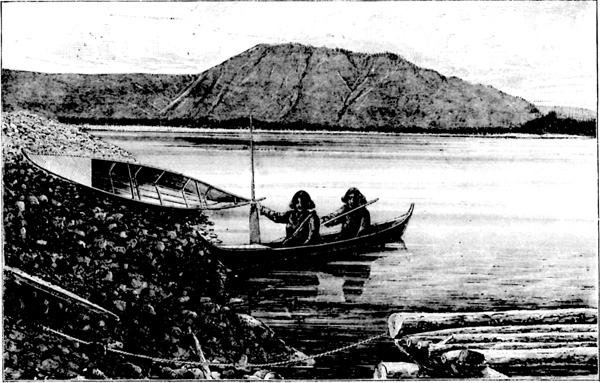
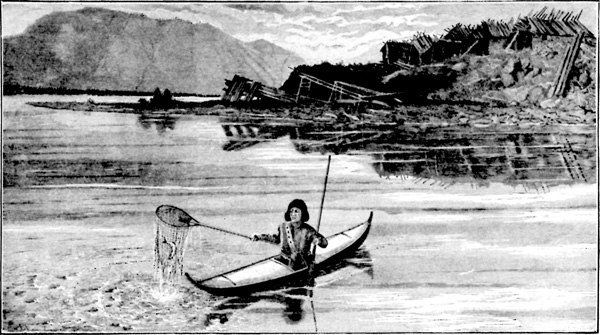
1, 2 Two types of canoes employed by Indians of the Fort Selkirk area.
(Frederick Schwatka, Along Alaska's Great River [New York: Cassell
& Company (1885)], pp. 221, 253.)
|
II
The white man was not the first to pierce the Yukon's natural
defences. The Indian preceded him by thousands of years, by way of the
land bridge that then permitted migration across the Bering
Strait.1 Little is known of these Indians and their way of
life before the arrival of the whites. After contact had been
established, native culture was evaluated from a technological
perspective and judged primitive. "Civilization," as understood by the
early explorers and traders at least, was unknown to the Indian. While
it is undeniable that the apparent simplicity of native culture was in
some measure shaped by geography and climate, these factors were not
primary for the white man ultimately shared the same region under the
same conditions and, if his culture was at best that of the frontier, it
was nonetheless technologically more advanced.
What distinguished the culture of the Russian and the European in the
North from that of the indigenous peoples were certain values on the
one hand and on the other the existence of a transportation
system which made possible provisioning and supply, as well as
communication, with the outside.

3 A sled used by the Indians of the lower Yukon River.
(W.H. Dall, The Yukon Territory [London: Downey, 1898], p. 166.)
|
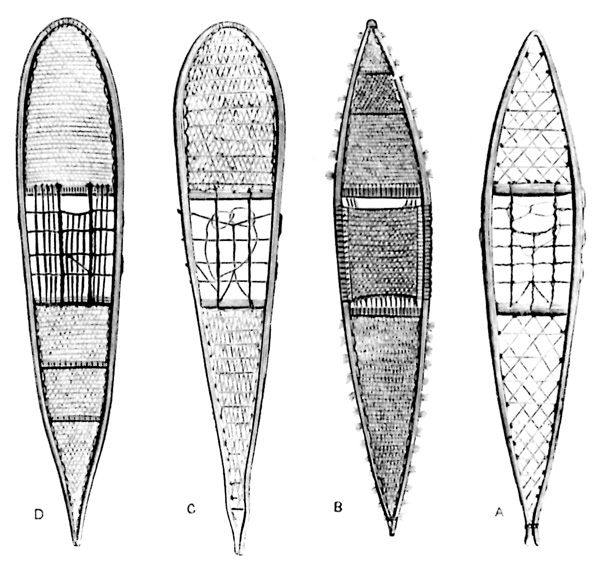
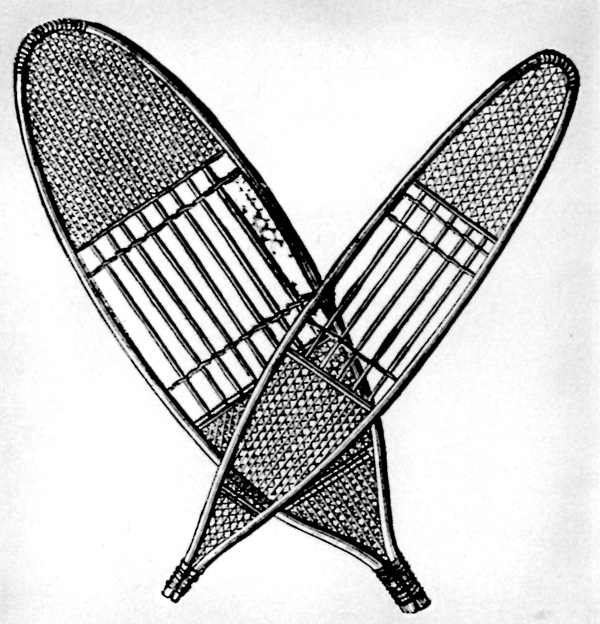
4, 5 various types of northern snow shoes. 4, A is an Eskimo or
Inuit type, except for the interstices and flat surface, it is similar
in design and size to B, the Hudson's Bay Company snow shoe.
C and D, approximately twice as long as A and B,
were used by the Ingalik and Kutchin Indians respectively, of the lower Yukon.
(W.H. Dall, The Yukon Territory [London: Downey, 1898], p. 190.)
5, The broader of the two Chilkat snowshoes was used for packing
supplies; the narrower, for hunting.
(Frederick Schwatka, Along Alaska's Great
River [New York: Cassell & Company (1885)], p. 87.)
|
The distinction between a transportation system and the modes of
transportation is important. A comparison of the forms of
transportation used by both the Indians and the whites in the Yukon, at least
until the introduction of steamboats on the Yukon River, reveals that
both were similar. Like the whites, the Indians were dependent on the
river during the summer months. With bark canoes, which provided the
principal means of travel, the Indians enjoyed sufficient mobility to
sustain their existence. Built by the women of each tribe, who stretched
the bark over wooden frames and pitched the joints to make them
waterproof, these canoes were propelled by either paddles or a
pole.2 In winter transportation was by dog sled, toboggan or
snowshoe. The sleds and toboggans were made of birch, the various
components being lashed together with leather thongs. No nails or wooden
pegs were used. The sleds were fitted with thin, broad runners designed
to bend with the declivities of the snow. The runners, in turn, were
shod with a thin veneer of bone and iced to reduce surface friction. The
Indian sleds were light and fast and capable of carrying heavy loads
over smooth ice. To assist the dogs pulling the sleds, the Indians
generally preceded them and broke trail with their
snowshoes.3
The climate established a seasonal pattern of transportation in the
Yukon characterized by the alternating use of water and overland forms
of travel that was to persist until the early 1950s. The effects of
this dependence on the climate and the rhythm to existence which it
produced were to have a marked influence on the history of the area.
III
The first whites to enter Alaska were the Russians. Though they never
pushed far enough into the interior to cross the boundary that separated
the Yukon from Alaska,4 they did establish a gateway to the
Yukon which was to be of vital importance throughout the 19th century.
That gateway was the Yukon River, via the port of Saint Michael, 70
miles north of the mouth of the Yukon. The Russians came in search of
furs and in the process established a commercial empire in Alaska with a
feudal society.5 The Russian monopoly went unchallenged until
the late 1830s and the 1840s when the Hudson's Bay Company, pursuing a
policy of westward expansion after their union with the North West
Company in 1821 and making use of a series of posts on the Mackenzie
River, broke through the barriers which had theretofore isolated the Yukon
from British commerce.
The fur trade, the magnet which drew the white men into the
Northwest, hinged on two factors: the existence of fur-bearing animals
and a network of water routes for transportation. The dependence of the
fur trade on the water routes was critical since these routes made the
Hudson Bay Company's penetration possible and prospective trading-post
sites were chosen "largely on the requirements of water transportation."6
Dependence on water travel survived long after the Company had withdrawn
from the Yukon; in fact, it characterized transportation in the Yukon
until the 1950s when the last sternwheeler on the Yukon River was
finally beached.
The Hudson's Bay Company broke through the natural barriers that
separated the Yukon from the Mackenzie District in a pincer movement,
using the Mackenzie River as the source for all exploration west. In
1840 Robert Campbell was commissioned by the Company "to explore the
north branch of the Liard to its source and to cross the height-of-land
in search of any river flowing to the westward."7 In May of
the same year, Campbell and a party of seven set out from Fort Halkett
on the Liard and followed that river to its junction with the Dease.
From there Campbell swung north to Frances River and on to a mountain
lake, which he named Frances in honour of Lady Simpson. Beyond the lake
he entered the Finlayson River, reached Finlayson Lake and portaged to
another river which he called the Pelly, after the governor of the
Hudson's Bay Company. He then retraced his movements and rejoined the
main party at Finlayson Lake.8 Two years later, in 1842, Campbell
established the first Hudson's Bay Company post in the Yukon at Frances
Lake.9 During the next six years Campbell opened up the
southeastern section of the Yukon for the Company, establishing another
site at Pelly Banks, and explored the Pelly, Lewes and Yukon rivers. In
1848 he built Fort Selkirk at the confluence of the Yukon and the
Pelly.10
In the meantime, traders of the Company had been active in extending
the trade to the northern portion of the Yukon using the Porcupine
River. John Bell, a chief trader, who had built Fort McPherson in the
North West Territory in 1840, discovered the Rat River and explored the
Porcupine to its mouth in 1842. In 1847 Alexander Murray was
commissioned to establish a post at the confluence of the Porcupine and
the Yukon. Leaving Fort McPherson in July of 1847, he proceeded to La
Pierre's House where he embarked in the Pioneer to the mouth of the
Porcupine. At the mouth of the latter river he selected a site for a
trading post and build Fort Yukon.11 Though located in
Russian America (later Alaska) just a few miles to the west of British
territory, the commercial advantage of locating at the junction of the Porcupine and
the Yukon outweighed diplomatic considerations in this remote area and
Fort Yukon become the focal point for the Company's dealings in the
northern Yukon.
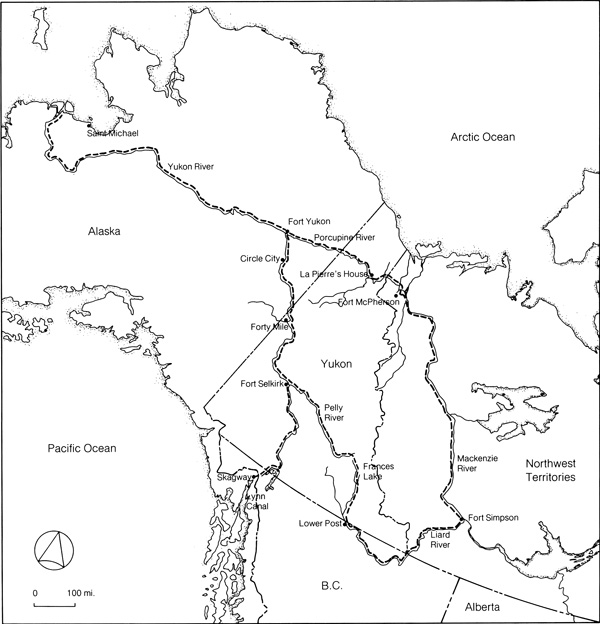
6 Routes to the interior.
(Map by S. Epps.) (click on image for a PDF version)
|
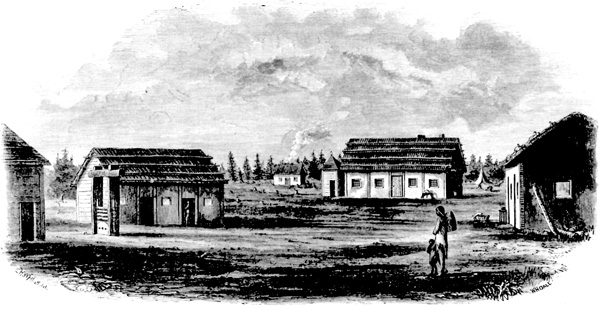
7 Fort Yukon, June 1867. The fort stockade, not shown, was later
used as fuel for steamers on the Yukon.
(W. H. Dall, The Yukon Territory [London:
Downey, 1898], facing p. 103.)
|
By 1847 the Hudson's Bay Company had established two water routes to
the Yukon from the Mackenzie River. In 1851 Robert Campbell made his
historic trip from Fort Selkirk down the Yukon River to Fort Yukon,
thereby establishing that the Yukon and the Pelly were on the same
watercourse.12 This discovery was of great significance.
Posts in the southern Yukon had always been difficult to provision
owing to dangerous travelling conditions on the Liard. With the
discovery that the Pelly and the Yukon were on the same watercourse, the
Liard route was abandoned in favour of the Porcupine.13 From
1852 until 1869, when the Hudson's Bay Company was expelled from Fort
Yukon by the United States government, the Porcupine was the main
gateway to the Yukon interior.14
The pursuit of the fur trade in the Yukon by the Hudson's Bay Company
was at best a marginal enterprise. The limitations of the transportation
system and the resulting high costs were factors that the Company was
never able to overcome. These difficulties were exacerbated by the
Indians' hostility to white incursion, a prime example of which was the
destruction of Fort Selkirk by the Chilkats in 1852. However, occasional
manifestations of open hostility by the Indians was secondary and in the
case of Fort Selkirk, possibly a consequence of the inadequacy of a
transportation system that made it difficult to supply the fort and
which only served to entice the Chilkats to take strong measures to
regain their historic monopoly over the trade of the southern interior.
Within the Company itself there had been a continuing debate over the
profitability of the Yukon trade. In arguing for the abandonment of the
southern posts, one chief factor noted that losses were incurred from
1848 to 1850 at the Frances Lake, Pelly Banks and Fort Selkirk posts and
that during its last year of operation (1851) Fort Selkirk showed a loss
again.15
An examination of the transportation problems that plagued the
Hudson's Bay Company illustrates the impossibility of conducting the
Yukon fur trade on a profitable basis from the East. According to Innis,
sleds employed by the Company in the Yukon were smaller than those used
elsewhere with the result that furs had to be packed in smaller
bundles.16 The isolation of the Yukon posts made provisioning
difficult and response to changing Indian trade demands almost
impossible. George M. Dawson, chief dominion geologist, later noted that
it had taken seven years for the returns from Forts Yukon and Selkirk to
reach the market. The course of trade was as follows:
Goods. — 1st year, reach York Factory; 2nd year,
Norway House; 3rd year, Peel River, and were hauled during the
winter across the mountains to La Pierre's House; 4th year, reach Fort
Yukon. Returns. — 5th year, reach La Pierre's House and are
hauled across to Peel River; 6th year, reach depot at Fort Simpson; 7th
year, reach market.17
As a result, the Company was forced to restrict the Yukon trade
to furs of high value, a fact which adversely affected its competitive
position with the Russians.18
With the expulsion of the Hudson's Bay Company from Fort Yukon in
1869, a phase of transportation history in the Yukon closed. During this
phase two river routes had been opened up to the Yukon interior. Neither
was to be of lasting significance. The very nature of the fur trade as
practised by the Hudson's Bay Company discouraged settlement and with it
the introduction of more highly developed transportation
forms.19 The Company had employed the same conveyances as the
natives, with minor modifications. Of these the "Hudson Bay Sled" and
snowshoe were the most important. The former was, in fact, a toboggan
nine feet long made from three birch planks held together by
crosspieces. The load was carried in a large moose-skin bag lashed to
the sled. The toboggan style was adopted because it was more suitable
for carrying heavy loads than the conventional sled. Nevertheless, this
adaptation in favour of carrying capacity necessitated the sacrifice of
several useful features common to the more conventional style of sled.
As a result, the Hudson Bay sled was hard to guide, difficult to take up
a hill and practically impossible to keep on the trail when travelling
along a hillside. Because the floor of the sled rode close to the
surface, the load was subject to water and snow damage. Progress was
slow unless travelling over hard-packed snow. With this in mind, the
Company designed a special snowshoe for trail use. This snowshoe had a
packing effect which facilitated the movement of the sled. The Hudson
Bay snowshoe was small, 30 inches being the regulation length. It was
pointed at both ends, the front being curved upward and fitted with a
knob to break the crust. For other types of winter activity such as
hunting, the traders used a larger snowshoe modelled after the "Kutchin"
Indian style.20 Only at Fort Yukon, where two boats, 30 feet
8 inches long with 9-foot beams, were built in 1848, was any attempt
made to introduce boats and these were limited to the movement of goods
on the Porcupine River to La Pierre's House.21

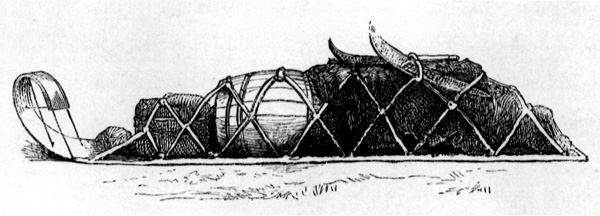
8, 9 Two versions of a Hudson's Bay Company sled. Figure 8 appears
to be a more accurate rendering of the sled.
(W. H. Dall, The Yukon Territory [London:
Downey, 1898], p. 165; Frederick Whymper, Travel and Adventure in the
Territory of Alaska [London: John Murray, 1868], p. 230.)
|
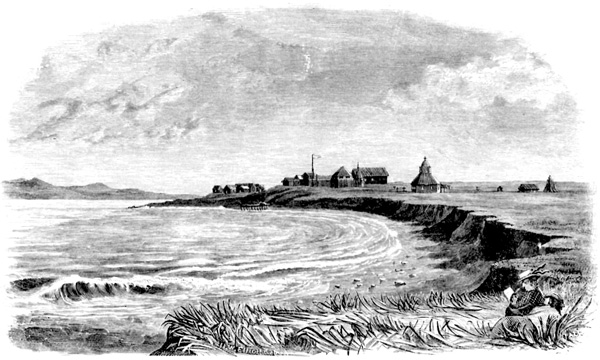
10 Saint Michael, Alaska, circa 1865. Located 70 miles from the
mouth of the Yukon, Saint Michael afforded the closest harbour
for ocean-going ships. Supplies were then transferred to river
boats and conveyed up the Yukon River.
(W. H. Dall, The Yukon Territory [London:
Downey, 1898], facing p. 11.)
|
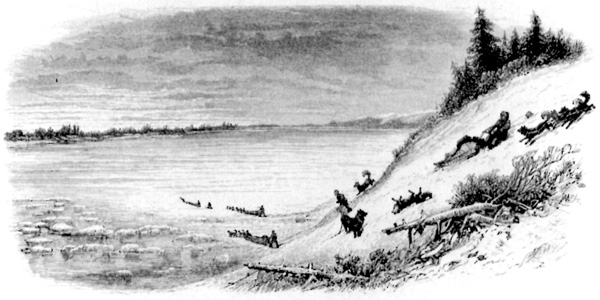
11 The mouth of the Yukon River, gateway to Alaska and the Yukon.
(Frederick Whymper, Travel and Adventure in the Territory of
Alaska [London: John Murray, 1868], facing p. 164.)
|
IV
In 1867 the United States purchased Alaska from Russia. While most
Americans tended to regard Alaska in much the same way as Voltaire had
regarded New France,22 one enterprising group of traders
turned its attention to the new American possession. The San Francisco
firm of Hutchinson, Kohl and Company, drawn to the Northwest by the
Pribiloff seal fishery, acquired the Russian trading posts and boats in
the territory. In 1868 the firm filed articles of incorporation
creating the Alaska Commercial Company.23 With the virtual
withdrawal of the Hudson's Bay Company from the Yukon in 1869, the
Alaska Commercial Company extended its interests to include the fur
trade of the interior and quickly established a commercial monopoly
over a region which included not only Alaska, but also the Yukon itself.
Until 1894 when Inspector Charles Constantine of the North-West Mounted
Police was despatched to the Fortymile district, the history of the
Yukon and Alaska can be said to have been virtually identical.
This period of Yukon history was characterized by two forms of
economic activity — fur trading and prospecting. With each passing
year, however, prospecting become the more important of the two. The
Alaska Commercial Company retained its interest in the fur trade, but
the trapping was done by Indians or prospectors who sought to supplement
the small returns from their diggings. Unlike the Hudson's Bay Company
experience, the two forms of economic activity proved to be relatively
complementary under the aegis of the Alaska Commercial Company.
The establishment of the Alaska Commercial Company in Alaska and the
Yukon led to the abandonment of the old Hudson's Bay Company trade
routes. After 1867 the principal gateway to the Yukon interior was the
Yukon River via Saint Michael. The adoption of the old Russian trade
route after 1867 had a profound effect on the development of
transportation in the Yukon. It not only involved a significant change
in access, but also made possible the introduction of steam-powered
vessels — the first major technological innovation in the
transportation history of the Yukon.24
The first steamboat on the Yukon River was the Wilder, a small
craft employed by the Russian-American Telegraph Company.25
W.H. Dall, an American explorer, likened the vessel to an old-fashioned
flatiron and remarked that it was "just about as valuable for the
purpose required. Unable to tow anything, or to carry any freight, while
in a breeze of any strength it was no easy matter to steer," the
Wilder can hardly be said to have marked an auspicious debut for
a form of transport that was to dominate Yukon transportation for
almost a century.26
Regular river service was introduced in 1869 when the Alaska
Commercial Company launched the sternwheeler Yukon and augmented
two years later with the launching of the Western Fur and Trading
Company's St. Michael. Both were small craft, 70 to 80 feet in
length, 14 to 20 feet in width, with a draft of 3 to 4 feet. Fitted with
powerful wood-burning engines, each boat was designed to push a barge
when necessary, each barge having a maximum capacity of ten tons. The
Canadian surveyor William Ogilvie, who had been commissioned to
establish the 141st meridian for boundary purposes and who was to later
enjoy a conspicuous place in the history of the gold rush, wrote that
the Yukon "could make a round trip from St. Michael to any point
in the vicinity of the boundary line in about a month, the upstream time
being twenty days." In 1871 the Yukon went up the river as far as
Fort Selkirk. Until 1898 when sternwheelers began to run on the upper,
or Bennett-Dawson, section of the Yukon River, no sternwheeler ever went
above the site of Campbell's old trading post.27
It was the fur trade that had lured the Alaska Commercial Company to
the Northwest. By the early 1870s, however, a new interest was
generated which was to overwhelm the trade in furs and almost totally
replace it.28 This new interest was gold.
The discovery of gold in California in 1848 precipitated a stampede
to the West Coast the following year. After the first burst of activity
in the California gold fields had passed and as individual mining
methods were steadily superseded by more advanced forms of mining
technology, the majority of those who had set out for the West Coast
settled down to the less romantic but profitable pursuit of settling
California. The rush to California had given birth to a breed of men,
however, to whom the search for gold was to become a lifelong obsession.
Beginning in the early 1850s, these men rushed to every new gold camp,
only to abandon it when news of another discovery reached them.
By the 1860s the trail of gold camps had led to the Cariboo district
in British Columbia.29 The expansion of gold-mining activity
in the West, beginning in California and culminating in the Cariboo,
had followed a roughly northern course. This pattern of expansion
suggested to some of the more speculative prospectors that there might
be a belt of gold running north to south on the western lip of the
hemisphere that had its source somewhere in the Yukon or Alaska. In the
early 1870s these men began to trickle into the Yukon to test their
hypothesis.
Of these men, four stand out as major figures in the history of the
Yukon: Leroy Napoleon "Jack" McQuesten, Al Mayo, Arthur Harper and
Joseph Ladue. McQuesten, Mayo and Harper reached the north in 1873 via
Fort Yukon and the Porcupine River. In 1874 they entered the employ of
the Alaska Commercial Company.30 During the next 20 years
they opened trading posts, prospected, and assisted other prospectors
throughout the territory with supplies, credit, transportation and
advice. Joseph Ladue joined them in 1882.
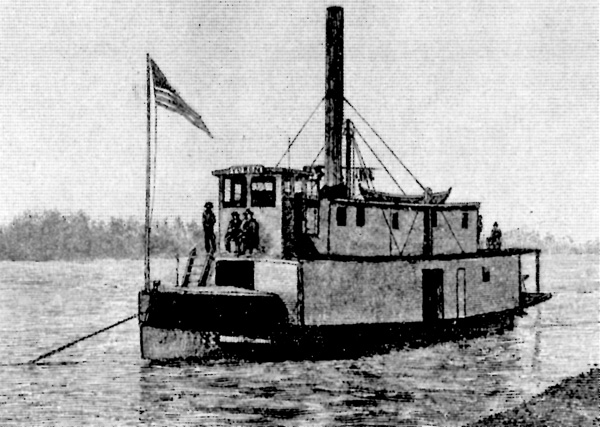
12 The Alaska Commercial Company steamer Yukon.
(U.S. Army. Department of the Columbia,
Report of a Military Reconnaissance in Alaska, Made in 1883, by
Frederick Schwatka [Washington, D.C.: GPO, 1885], p. 44.)
|

13 The SS St. Michael, grounded on a bar near Fort Yukon.
Owned originally by the short-lived Western Fur and Trading Company
(also referred to as the Northern Trading Company), the St.
Michael was subsequently taken over by the Alaska Commercial Company.
(U.S. Army. Department of the Columbia, Report of a Military
Reconnaissance in Alaska, Made in 1883, by Frederick Schwatka
[Washington, D.C.: GPO, 1885], p. 43.)
|

14 Juneau, Alaska. Before the Klondike gold rush, Juneau was the main
outfitting port for prospectors bound for the Yukon via the Chilkoot
Trail. It was the last port-of-call for vessels running up the Inside
Passage and the place where prospectors arranged for transportation
to Dyea.
(Chicago Record, Klondike [Chicago: Chicago
Record Co., 1897], p. 92.)
|
It might be said of each of these men that they were frustrated
miners. None of them ever discovered the gold that had drawn them north,
but they were not failures. Without them, as Pierre Berton has
appropriately written, "the series of events that led to the Klondike
discovery would not have been possible. Without the string of posts they
set up along the Yukon, the systematic exploration of the river country
could not have taken place."31 This string of posts, moreover,
furnished a framework for the first internal transportation network in
the Yukon.
Excepting the major innovation in navigation that took place in the
late 1860s, no significant change in the Yukon transportation system
occurred until the early 1880s when a new route to the Yukon was opened
up. Located at the head of Lynn Canal, this new gateway originated at
Dyea, led over the Chilkoot Pass to the mountain-fed lakes in
northwestern British Columbia and down the Yukon River. For years the
Chilkat Indians had guarded the pass, denying the white man access in
order to protect their trading monopoly with the Indians of the
interior.32 In 1878 a prospector by the name of George Holt
used the pass and is generally recognized to have been the first white
man to successfully deny the Indian interdict.33 Two years
later the pass was opened to all when the USS Jamestown used
gunboat diplomacy to "persuade" the chief of the Chilkat Indians to
allow free access to it. From 1881 the Chilkoot Pass became the main
portal used by miners going into the Yukon.34
Movement over the Chilkoot Pass was difficult, the trail being a
veritable obstacle course. The path over the summit, steep and
rock-strewn, made it impossible to use pack animals for the through
journey between Lynn Canal and the lakes on the other side.35
The Chilkat Indians, no longer able to restrain the whites from using
the pass, turned the situation to their own advantage by taking up the
profitable pursuit of packing prospectors' supplies over the
summit.36
With the discoveries of gold along the bars of the Stewart River in
1886 and on the Fortymile in 1887, the influx of miners into the region
increased in intensity. As a result, a pattern that had begun to emerge
as early as 1882, when prospectors first began to use the Chilkoot
Trail, was established by 1887. This pattern was to persist with only
slight modification up to and including the gold rush of 1898.
There has been an unfortunate tendency to associate everything
pertaining to the Klondike gold rush with having been a product of it.
Nowhere has this tendency been more misleading than in the history of
the development of transportation in the Yukon. A cursory examination
of what took place during the 1880s, with specific reference to the
Lynn Canal gateway to the interior, reveals that the main outlines of
the gold-rush transportation system had been laid long before
1897-98.
In 1886 a trading post was built on the tidal flats at Dyea by John
J. Healy. Here the prospectors debarked from steamers which had carried
them up the Inside, or Inland, Passage, purchased their supplies and
made arrangements with Healy for the packing of their possessions over
the trail. Thus the first organized economic enterprise to serve miners
going into the Yukon from the Alaska Panhandle predated the gold rush by
12 years. By 1887 Sheep Camp, three-quarters of the way up the Dyea
trail, had been established as the main stopping-off point on the
coastal side of the pass, just as it was to be during the gold
rush.37 As early as 1887, prospectors were whipsawing timber
and building boats at Bennett Lake for the trip down the Yukon River and
William Ogilvie's observation, made in the same year, that the supply of
lumber for boat building had become practically exhausted suggests that
this had been going on for some time.38 The tent city of
thousands that ringed the southern bank of Bennett Lake in the spring
of 1898 may have shocked the newspapermen who were despatched by their
publishers to report on the Klondike phenomenon, but to those who had
been in the Yukon for some years it was only the culmination —
surprising in its extent to be sure — of a process that had begun
at least ten years earlier.
In retrospect, the 1880s stand out as a decade of great progress in
laying the framework of the gold-rush transportation system. For the
first time accurate information was accumulated concerning
transportation routes as a result of the explorations of Frederick
Schwatka, an American army officer, and Canadians George M. Dawson and
William Ogilvie.39 A portage road, replete with rollways and
windlasses to transfer boats, was built in 1887 on the east bank of the
Yukon River across from the present townsite of Whitehorse to bypass the
Whitehorse Rapids.40 In the same year, Dawson notified the
minister of the Interior that Edward Bean had obtained permission from
the United States government to build a road over the White Pass, some
six miles east of the Chilkoot, and reported the rumour that a railroad
was to be built over the Chilkoot.41 Although Bean had
petitioned the secretary of the Interior for a franchise to construct a
trail over the White Pass, his request had been refused on the grounds
that Congress was the only body empowered to grant franchises. Bean was
not the last person to seriously contemplate a trail over the White Pass
before the gold rush. At least two more unsuccessful applications for a
franchise were made, one in 1888, the other by William Moore in
1891.42
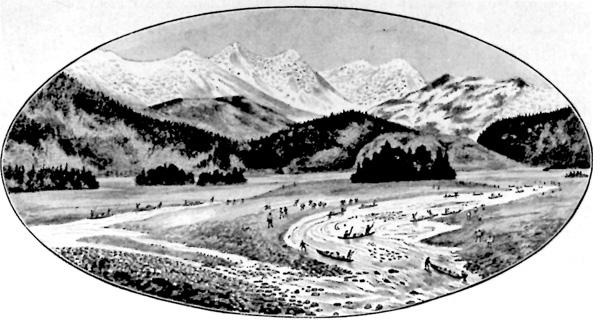
15 Near Dyea, Alaska, the southern terminus of the Chilkoot Trail,
in the early 1880s.
(Frederick Schwatka, Along Alaska's Great
River [New York: Cassell & Company (1885)], p. 65.)
|
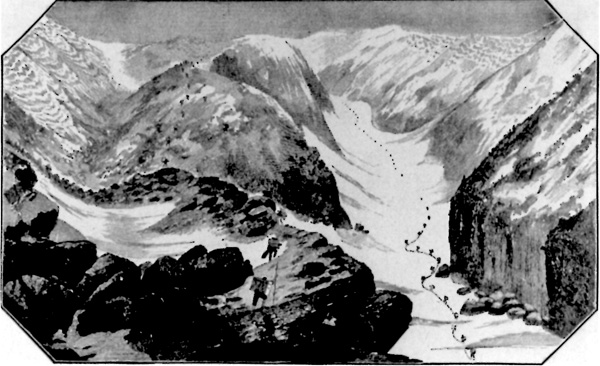
16 An artist's impression of the Chilkoot Pass (Schwatka's Perrier
Pass) 14 years before the great stampede. Schwatka named many of
the geographical features on the Chilkoot and upper Yukon.
(Frederick Schwatka, Along Alaska's Great
River [New York: Cassell & Company (1885)], p. 85.)
|
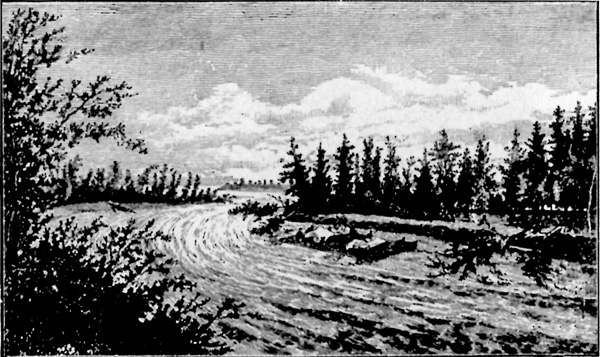

17, 18 Navigation problems on the upper Yukon River. 17,
A raft negotiating sweepers (trees or brush disloddged by
riverbank erosion). 18, Running aground was much more
common and often meant long hours of unloading, easing the craft
off the bar and reloading before once more getting under way.
(Frederick Schwatka, Along Alaska's Great
River [New York: Cassell & Company (1885)], p. 134, 145.)
|
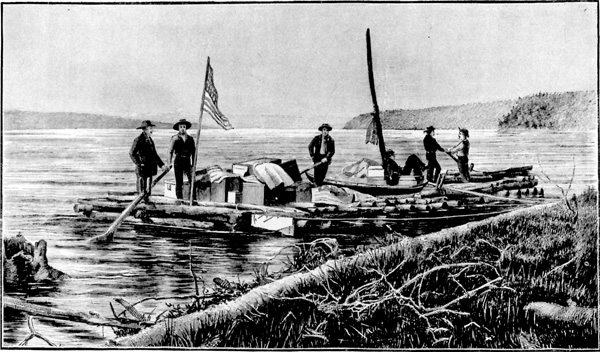
19 The raft which carried U.S. Army lieutenant Frederick
Schwatka and party from the headwaters of the Yukon to
central Alaska in 1883.
(Frederick Schwatka, Along Alaska's Great
River [New York: Cassell & Company (1885)], p. 311.)
|
While none of these schemes bore fruit, they do suggest that the
pre-gold-rush Yukon showed enough economic potential to justify
speculative consideration being given to substantial improvements to the
transportation system. Furthermore, they suggest that ambitious
transportation schemes were not simply products of gold-rush hysteria.
While it is important to bear in mind that charter and/or franchise
applications do not necessarily prove serious intent on the part of the
applicant, it should be noted that governments, not individuals, were
the usual risk takers in the construction of "development" roads during
the 19th century and that the absence of legislation providing for a
franchise — and to an even greater extent the corollary subsidy
— may well have been a factor in postponing a series of schemes
that was economically premature.43
To serve the ever-growing human influx, sternwheeler operations on
the lower river were expanded. In 1883 a small sternwheeler, the
New Racket, was constructed. The Alaska Commercial Company built
the Arctic, one of the first of the larger boats on the lower
river (140 feet long, 28 feet wide, with a 6-foot hull), in 1889 and it,
like its predecessors, made the Saint Michael-Fort Selkirk
run.44
In 1892 the monopoly of the Alaska Commercial Company was broken with
the formation of the North American Transportation and Trading Company,
a Chicago-based firm with its Yukon headquarters at Cudahy. An immediate
result was a reduction in prices and the supplying of better goods by
both companies.45 Another significant consequence was the
North American Transportation and Trading Company's decision to go into
the navigation business. The Portus B. Weare, the first of the
company's sternwheelers, was placed in service in 1892. A short time
later the John J. Healy followed. Responding to the challenge of
its new competitor and to the needs of the growing northern population,
the Alaska Commercial Company added the Alice (1895) and the
Bella (1896) to its fleet of river boats.46
Excepting the introduction of steam-powered vessels on the lower
river, modes of transportation remained primitive between 1869 and 1896,
just as they had been during the Hudson's Bay Company's presence.
Canoes, rafts and sleds continued to be the principal forms of domestic
travel, the birch-bark type of canoe giving way to cottonwood dugouts
after 1869.47 Poling boats were introduced by the miners
during the 1880s and used on the Yukon River and its tributaries. They
were particularly well-suited to upstream travel. Long, narrow, and
pointed at both ends, these craft were propelled by two men sinking
poles through the water and pushing on the riverbed. At times the poles
were augmented by a canvas sail.48
An important innovation in overland travel occurred during this
period with the introduction of horses.49 The earliest record
of horses in the Yukon dates from 1891 when Jack Dalton and E.G. Glave
brought horses in over what was later to be known as the Dalton
Trail.50 There is also evidence to suggest that horses were
used infrequently at Dyea before this time, but the nature of the
Chilkoot Trail prevented them from being brought into the Yukon
profitably. Another factor limiting the use of horses was the lack of
food. It was generally believed that native grass was not nutritious
enough to sustain horses and the costs involved in bringing in hay were
too high to make importation feasible. There was also some discussion as
to whether horses could withstand the climate and, since it was felt
that horses would have to be shod, it was believed that the iron shoes
would freeze solid to the ice or else freeze the horses' feet. Despite
these apparent drawbacks, horses were brought into Forty Mile in 1893
and were in general use at Circle City after 1894.51 However,
the horse did not seriously challenge the status of the dog as the
primary motive force in overland transportation during this period.
V
On the eve of the Klondike gold rush the Yukon interior was served by
two transportation networks, each originating in Alaska: one on Lynn
Canal, the other at Saint Michael. Each fulfilled a separate function.
The former was the avenue of migration, the latter the highway of trade.
In keeping with this functional nature, the forms of transportation for
each were distinct. The lower river was the private preserve of the
sternwheeler and the trading companies.52 The Lynn Canal, on
the other hand, was atomistic in nature, serving individuals or small
parties of prospectors who crossed the Chilkoot Pass on foot and
travelled down the Yukon River system in small boats of their own
construction. Interestingly enough, both of these networks were to
retain their pre-gold-rush characters during the great stampede.
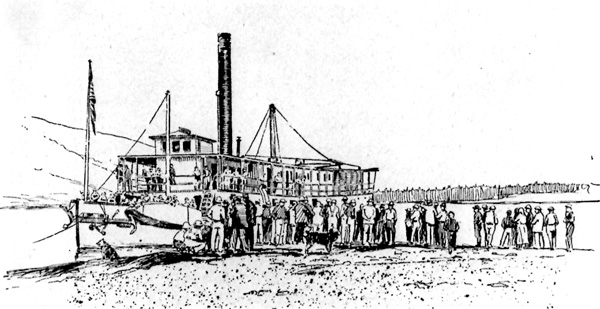
20 The arrival of a steamboat was an occasion. Whole settlements
would greet the latest purveyor of goods and news from the
outside.
(Chicago Record, Klondike [Chicago: Chicago Record
Co., 1897], p. 268.)
|
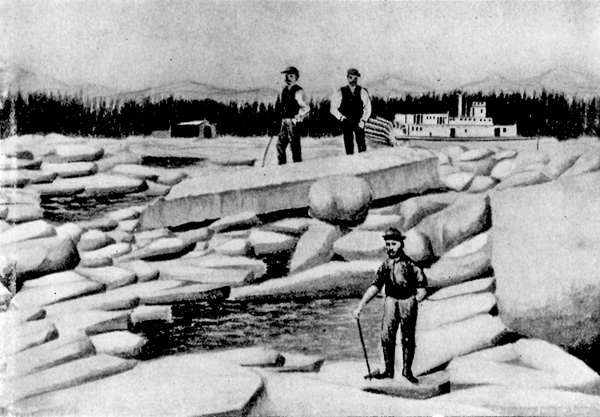
21 Seasonality was the one obstacle river transport never
surmounted. Here the Portus B. Weare is trapped in
the ice at Circle City while its crew looks in vain for a
channel.
(Ernest Ingersoll, Gold Fields and the Klondike
and the Wonders of Alaska [n.p.: Edgewood (1897)], p. 338.)
|
|

